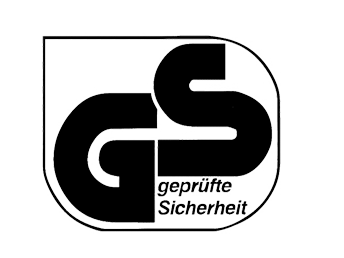
GS Certification
GS means German Geprufte Sicher heit (safety certification) and German Safety. GS certification is a voluntary certification based on the German Product Safety Act (SGS) and tested in accordance with the European Union unified standard EN or German industrial standard DIN. It is a recognized German safety certification mark in the European market.
The GS mark indicates that the use safety of the product has passed the test of an independent agency with credibility; Although the GS mark is not mandatory by law, it can make the manufacturer subject to strict German (European) product safety laws in case of accidents caused by product failure; So GS logo is a powerful market tool, which can enhance customer confidence and purchase desire. Although GS is a German standard, most European countries agree with it, and the products will also meet the requirements of the CE mark of the European Community while meeting GS certification; Unlike CE, the GS mark has no legal mandatory requirements. However, as the safety awareness has penetrated into ordinary consumers, an appliance with GS mark may have greater competitiveness than ordinary products in the market.
The necessity and benefits of applying for GS certification
- As a symbol of product safety and quality reliability, GS has been widely recognized by German and European consumers;
- Enhance manufacturers’ confidence in product quality, safety and compliance with legal requirements;
- Emphasize to consumers the manufacturer’s obligations for product quality and safety;
- The manufacturer can ensure to the end user that the product with GS mark has passed the test of the third party testing agency;
- In many cases, the quality and safety of products with GS logo exceed the level required by law;
- The GS mark can obtain higher recognition than the CE mark because the GS certificate is issued by a qualified third-party testing agency.
GS Certification Issuing Authority
- German certification bodies: The domestic well-known GS licensors in Germany include TUV RHEINLAND, TUV SUD, VDE, etc., which are directly recognized by Germany.
- Other certification bodies: Generally, other GS certification bodies in Europe that cooperate with Germany include KEMA, ITS, NEMKO, UL (DEMKO), SGS, Continental, etc.
GS certification process
- First meeting: through the first meeting, the testing agency or agency will explain the specific certification procedures and relevant standards to the applicant’s product engineer, and provide the required documents and forms.
- Application: The applicant shall submit the documents that meet the requirements. For electrical products, it is required to submit the general assembly drawing, electrical schematic diagram, material list, product purpose or use and installation instructions, and the difference between series and models.
- Technical meeting: After the inspection institution has checked the applicant’s documents, it will arrange a technical meeting with the applicant’s technical personnel.
- Sample test: the test will be carried out according to the standards used, and can be carried out in the manufacturer’s laboratory or any of the laboratories of the inspection agency in various countries.
- Factory inspection: GS certification requires inspection of safety-related procedures at production sites.
- Issue GS certificate.
Technical data to be submitted for GS certification
- Fill in the application form;
- Sign the general agreement;
- Data required for safety assessment;
The CB certificate of the product can be provided, which must include the European group difference Or provide the information required for safety assessment;
Operating instructions of the product (including safety warning, maintenance instructions, accessories installation instructions, etc.);
Parts list (according to the requirements of relevant standards, provide the information of key safety parts used in the product; the information of parts may include the manufacturer, model, parameters, certification information, and the requirements of parts and components need to consider the requirements of parts and components standards and final product standards)
Circuit diagram and layout;
Product structure diagram;
Specification of transformer and other parts.
- Parts in contact with food, if any
Please provide the food hygiene license document issued by the authority for the accessible black materials (plastic, coating, etc.), or the relevant test evaluation (PAH) is required.
- Nameplate (German, GS logo with correct size is required);
- Electromagnetic compatibility evaluation report (EMC) and factory compliance statement (DOC);
- Instructions in German;
- Samples during shipment to complete structural review, type test or ergonomic test evaluation;
- If applicable, the evaluation report of Noise and EN50332 shall be provided;
- If applicable, DMF and EMF evaluation reports shall be provided.
Time period and validity of GS certification
Cycle: the length of time depends on whether the product needs to be modified or the speed at which the manufacturer submits the required product documentation; Generally speaking, the time required is about 6-8 weeks;
Period of validity: GS certification is valid within 5 years after the issuance of the certification authority. Within the period of validity, the factory will review once a year. After 5 years, the product test will need to be conducted again to obtain GS certification.
